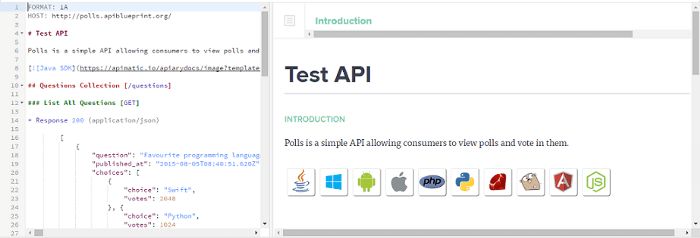
After the integration of APIMatic’s API consumption services into the Apiary’s API design offerings, the overall developer’s experience has led towards total automation of API delivery mechanism. APIMatic’s SDK generating Widget complements the current API documentations in Apiary with only a single click. This widget is a simple solution for generating SDKs in any of the 10 most popular languages for consuming APIs. Integrating APIMatic into your Apiary portal is actually quite easy. If you still haven’t performed this integration, then visit the tutorial. It is only a 4-step process.

Today, we are glad to introduce two of our new updates to this collaboration for all developers who want to extend API consumption and improve API capabilities. This blog highlights main attributes to our latest development.
Support for API Elements
Apiary has recently deprecated AST for parsing API Blueprint files and introduced a new format known as API Elements for describing APIs and complex data structures. Its format is so generic that it supports both Swagger and API Blueprint files in a rather more effective way. Since, all the Swagger and API Blueprint users are using API Elements, hence, it makes sense that APIMatic just cannot stay behind. In order to prevent our users from any sort of compatibility issues, we also brought our support for API Elements for its internal parsing of API Blueprint files. Hence now, conversion of API Blueprint markdown into JSON has gone even more efficient and effective.

Generate Test Cases Automatically
APIMatic has also released a new feature where we utilize the API Blueprint example values and request response body objects to automatically generate test cases. Users can then not only generate SDKs but can also easily test them.

If you have an existing API description in APIMatic with test cases, exporting it into API Blueprint would also load the example values from these test cases.

APIMatic in Action

Dude Solutions have completely automated their system by integrating the delivery mechanisms of both Apiary and APIMatic into their CI/CD life cycle. The deal with this automation is that once an API description is updated in the backend, APIMatic’s CodeGen API saves our customers from manually updating the NuGet changes and publishing them. All it takes is less than a minute from updating API descriptions to publishing the updated SDKs. This DevOps flow has reduced our customer’s time to release the updates from 3 weeks to 18 seconds. Not just this, they have also reduced a great amount of development and maintenance costs. Hence, as a result companies are provided with responsiveness and agility in their API management processes.
This is how APIMatic and Apiary are working together to enhance the overall developer’s experience by providing innovative and easy solutions. This widget is just one innovation; wait for more advanced features to come! Visit our website for amazing new API solutions.





